We may not have the course you’re looking for. If you enquire or give us a call on 01344203999 and speak to our training experts, we may still be able to help with your training requirements.
Training Outcomes Within Your Budget!
We ensure quality, budget-alignment, and timely delivery by our expert instructors.

Curious about how industries keep their operations running smoothly? Ever wondered What is SCADA? Well, wonder no more! SCADA, short for Supervisory Control and Data Acquisition, is the secret behind the scenes. It's the technology that helps companies monitor and control their processes, whether they're making cars, treating water, or generating electricity. In this comprehensive overview, we'll dive into the world of SCADA, exploring its evolution, architecture, working principles, and much more. Let's uncover the magic of SCADA together!
Table of Contents
1) What is SCADA (Supervisory Control and Data Acquisition)?
2) The development of SCADA over time
3) Architecture of SCADA system
4) Working of SCADA
5) Why is SCADA used?
6) Elements within a SCADA system
7) Key features of SCADA systems
8) Difference between Legacy and Modern SCADA
9) Conclusion
What is SCADA (Supervisory Control and Data Acquisition)?
SCADA, short for Supervisory Control and Data Acquisition, is a crucial technology widely employed in various industries for monitoring and controlling processes, both locally and remotely. It provides real-time data visualisation, analysis, and control capabilities, allowing operators to manage complex systems efficiently.
SCADA systems comprise hardware and software components that gather, process, and present data from remote locations. These systems are pivotal in manufacturing, energy, water treatment, transportation, and more, where monitoring and controlling processes are paramount.
What sets SCADA apart is its ability to gather data from sensors and instruments in real time, enabling operators to make informed decisions promptly. This technology significantly optimises operations, enhances safety, and improves overall productivity in industrial settings.
The development of SCADA over time
The evolution of SCADA traces back to the mid-20th century when industries began seeking ways to monitor and control processes more efficiently. Early systems relied heavily on manual intervention and basic control mechanisms.
However, the need for more sophisticated monitoring and control solutions became apparent as technology advanced. The 1970s witnessed significant developments in SCADA technology with the introduction of digital computers and programmable logic controllers (PLCs). These advancements allowed for more automated and reliable data acquisition and control processes.
Throughout the following decades, SCADA systems continued to evolve, incorporating advancements in communication technologies, data processing, and user interfaces. The integration of internet connectivity and cloud computing further revolutionised SCADA, enabling remote monitoring and control capabilities on a global scale.
Architecture of SCADA system
The architecture of a SCADA system typically consists of four main components: supervisory computers, remote terminal units (RTUs) or programmable logic controllers (PLCs), communication infrastructure, and human-machine interface (HMI) software.
Supervisory computers serve as the central control hub of the SCADA system, where operators monitor processes, analyse data, and issue commands. These computers have specialised software to communicate with remote devices and collect real-time data.
RTUs or PLCs are deployed in the field to interface with sensors, actuators, and other devices. They collect data from these devices and transmit it to the supervisory computers for processing. RTUs are typically used in remote locations where wired communication may not be feasible, while PLCs are more common in industrial settings with structured wiring systems.
The communication infrastructure facilitates data exchange between the supervisory computers and remote devices. This infrastructure may include wired Ethernet, serial communication (RS-232/RS-485), radio frequency (RF), and cellular networks.
Learn how to become a Barista with our Basic Barista Course – Sign up today!
Working of SCADA
The working of a SCADA system involves multiple steps, starting from data acquisition to process control and monitoring. Here's a simplified overview of how a SCADA system operates:
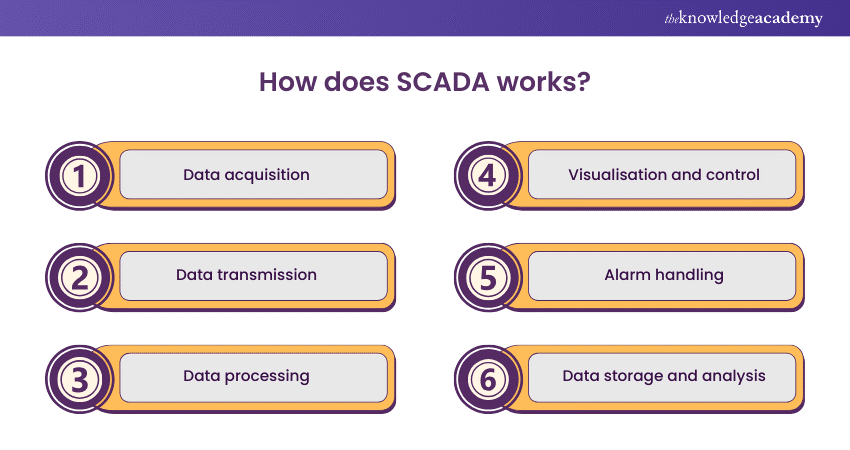
1) Data acquisition: SCADA systems collect data from sensors, meters, and other devices distributed across the monitored infrastructure. This data includes temperature, pressure, flow rate, and voltage.
2) Data transmission: Once collected, the data is transmitted to the supervisory computers via communication channels such as wired or wireless networks. Depending on the application's requirements, this transmission can occur in real-time or at regular intervals.
3) Data processing: Upon receiving the data, the supervisory computers process it using specialised software algorithms. This processing may involve calculations, data validation, aggregation, and analysis to derive meaningful insights into the operational status of the monitored processes.
4) Visualisation and control: Processed data is then presented to operators through the HMI software, which offers a graphical interface for visualisation. Operators can monitor various parameters, trends, and alarms in real time and take appropriate actions to control the processes if necessary.
5) Alarm handling: SCADA systems generate alerts and notifications when predefined thresholds or conditions are met, indicating potential issues or anomalies in the monitored processes. Operators can acknowledge these alarms and initiate corrective actions to eliminate risks and ensure smooth operations.
6) Data storage and analysis: SCADA systems often include features for storing historical data, allowing operators to analyse trends, identify patterns, and optimise processes over time. This data analysis helps improve industrial operations' efficiency, reliability, and safety.
Why is SCADA used?
SCADA is used in various industries for several reasons, including:
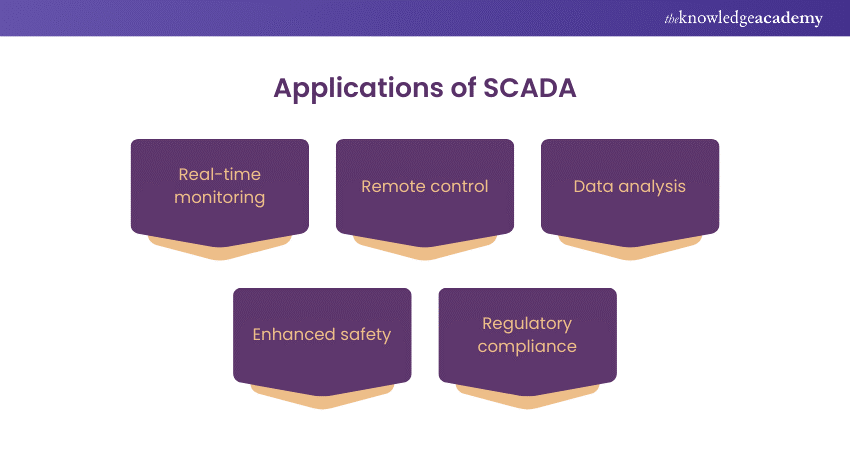
1) Real-time monitoring: SCADA systems provide real-time visibility into industrial processes, allowing operators to continuously monitor parameters and performance metrics. This helps identify issues promptly and take corrective actions to prevent downtime and optimise operations.
2) Remote control: SCADA enables remote monitoring and control of processes, allowing operators to manage operations from centralised locations. This capability is precious in industries with distributed assets or hazardous environments where human intervention may be limited.
3) Data analysis: SCADA systems collect and analyse vast amounts of data from sensors and devices, offering valuable insights into process performance, trends, and anomalies. This data analysis helps improve efficiency, predict maintenance needs, and optimise resource utilisation.
4) Enhanced safety: By enabling real-time monitoring and control, SCADA systems improve safety in industrial environments. Operators can respond quickly to emergencies, implement safety protocols, and mitigate risks to personnel and assets.
5) Regulatory compliance: Industries are subject to regulatory requirements regarding process monitoring, reporting, and control. SCADA systems help ensure compliance with these regulations by providing accurate data collection, documentation, and reporting capabilities.
Improve your Facilitation skills with our Facilitation Skills Training – Sign up today!
Elements within a SCADA system
A SCADA system comprises several key elements, each playing a crucial role in its operation:
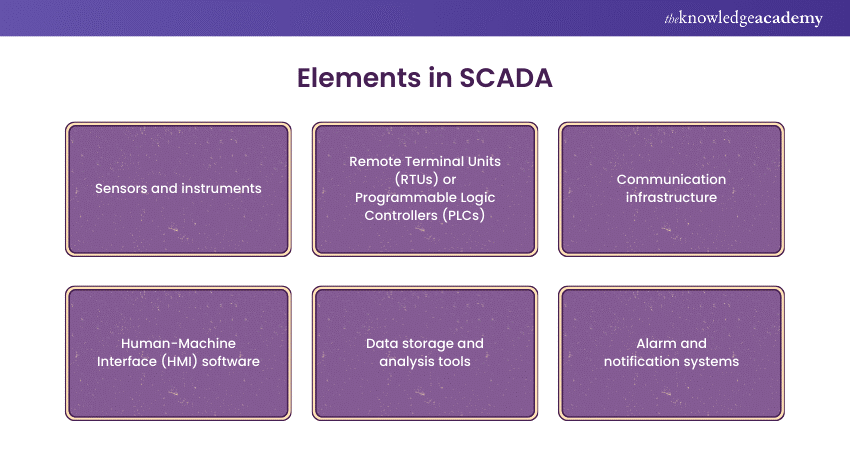
1) Sensors and instruments: These devices measure temperature, pressure, flow rate, level, and voltage in the monitored processes. Sensors convert physical quantities into electrical signals, which are then transmitted to the SCADA system for processing.
2) Remote Terminal Units (RTUs) or Programmable Logic Controllers (PLCs): RTUs or PLCs act as intermediary devices that interface with sensors and instruments in the field. They collect data from these devices, process it, and transmit it to the supervisory computers for further analysis and control.
3) Communication infrastructure: SCADA systems rely on various communication technologies to facilitate data exchange between remote devices and supervisory computers. This infrastructure may include wired Ethernet, serial communication (RS-232/RS-485), radio frequency (RF), and cellular networks.
4) Human-Machine Interface (HMI) software: The HMI software provides operators with a graphical interface to interact with the SCADA system. This interface allows operators to visualise data, control processes, respond to alarms, and access historical records using intuitive controls and displays.
5) Data storage and analysis tools: SCADA systems often include features for storing historical data and performing data analysis. This allows operators to track trends, identify patterns, and optimise processes over time, improving efficiency and performance.
6) Alarm and notification systems: SCADA systems generate alerts and notifications when predefined thresholds or conditions are met, indicating potential issues or anomalies in the monitored processes. Operators can configure alarm parameters and define escalation procedures to ensure timely response and resolution.
Key features of SCADA systems
SCADA systems offer several key features that make them indispensable tools for industrial automation and control:
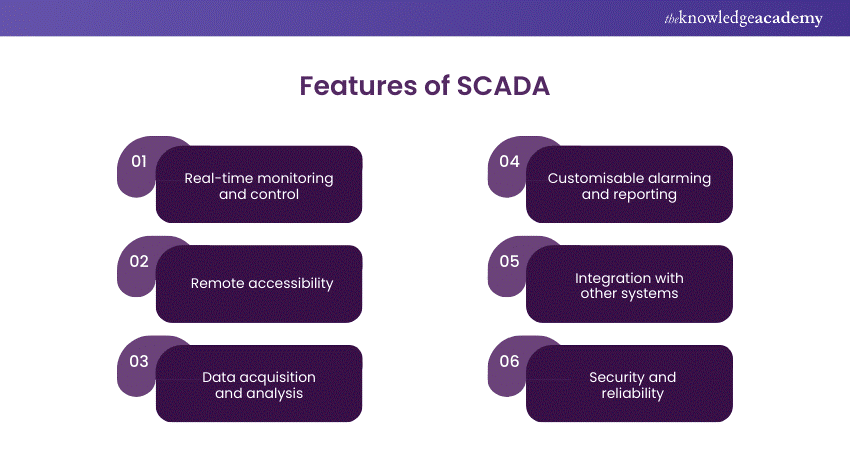
1) Real-time monitoring and control: SCADA systems provide real-time visibility into industrial processes, allowing operators to monitor parameters, trends, and alarms instantly. This enables prompt decision-making and intervention to ensure optimal performance and safety.
2) Remote accessibility: SCADA systems enable remote monitoring and control of processes from centralised locations, eliminating the need for physical presence at the site. This remote accessibility improves operational efficiency and flexibility, especially for geographically dispersed assets.
3) Data acquisition and analysis: SCADA systems collect and analyse large amounts of data from sensors and instruments, offering valuable insights into process performance, trends, and anomalies. This data analysis helps optimise operations, predict maintenance needs, and improve efficiency.
4) Customisable alarming and reporting: SCADA systems allow operators to configure alarm parameters and define escalation procedures to ensure timely response and resolution of issues. They also offer customisable reporting capabilities for compliance, analysis, and decision support.
5) Integration with other systems: SCADA systems can integrate seamlessly with automation and enterprise systems, such as Manufacturing Execution Systems (MES), Enterprise Resource Planning (ERP) software, and data historians. This integration enables data sharing, interoperability, and holistic management of industrial processes.
6) Security and reliability: SCADA systems employ heavy security measures to protect against data breaches, unauthorised access, and cyber threats. They use encryption, authentication, and access control programs to ensure critical infrastructure's confidentiality, integrity, and availability.
Explore the realm of Supply Chain Management with our Supply Chain Management Training today!
Difference between Legacy and Modern SCADA
While the fundamental principles of SCADA remain consistent, there are significant differences between legacy and modern SCADA systems in terms of technology, functionality, and capabilities:
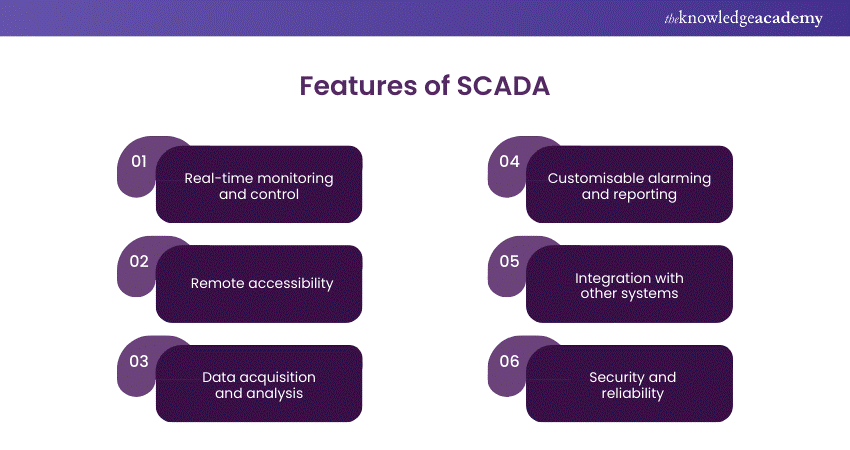
1) Technology stack: Legacy SCADA systems often rely on proprietary hardware and software platforms that may need more interoperability and scalability. In contrast, modern SCADA systems leverage open standards, modular architectures, and cloud-based solutions for greater flexibility and integration.
2) Communication protocols: Legacy SCADA systems typically use proprietary or legacy communication protocols, which may limit interoperability and data exchange with other systems. Modern SCADA systems support standard protocols such as OPC-UA, MQTT, and RESTful APIs, enabling seamless integration with diverse devices and platforms.
3) User interface and experience: Legacy SCADA systems often feature outdated user interfaces and limited visualisation capabilities, making it challenging for operators to interact with and interpret data effectively. Modern SCADA systems offer intuitive, customisable HMIs with advanced visualisation tools, trend analysis, and mobile access for enhanced user experience.
4) Data processing and analytics: Legacy SCADA systems may lack robust data processing and analytics capabilities, limiting their ability to derive actionable insights from collected data. Modern SCADA systems leverage advanced analytics, machine learning, and artificial intelligence algorithms to proactively analyse trends, predict anomalies, and optimise processes.
5) Scalability and flexibility: Legacy SCADA systems may need more scalability and flexibility, making it difficult to adapt to changing operational requirements and expand functionalities. Modern SCADA systems are highly scalable, modular, and flexible, allowing for seamless integration with new devices, protocols, and applications as needed.
6) Cost and Total Cost of Ownership (TCO): While legacy SCADA systems may have lower upfront costs, they may incur higher maintenance, upgrade, and integration expenses over time due to their proprietary nature and limited capabilities. Modern SCADA systems offer a more cost-effective solution in the long run, with lower TCO and higher return on investment or ROI due to their scalability, interoperability, and advanced features.
Conclusion
SCADA or Supervisory Control and Data Acquisition systems are indispensable tools for modern industries seeking to optimise performance, ensure safety, and maintain regulatory compliance in today's dynamic and competitive landscape. What is SCADA? It's a cornerstone technology driving efficiency, productivity, and innovation across diverse sectors, and its significance will continue to grow as industries embrace digital transformation and automation.
Learn more about the intricacies of SCADA with our SCADA Training – Join today!
Frequently Asked Questions

a) Enhanced efficiency: Real-time monitoring and remote accessibility streamline operations.
b) Improved security: Robust cybersecurity measures safeguard against threats.
c) Scalability: Easily expandable to accommodate evolving needs and technologies.
d) Advanced analytics: Data-driven insights optimise processes and decision-making.

a) Cybersecurity risks: Vulnerable to cyber threats due to increased connectivity.
b) Complexity: Integration with existing systems may pose challenges.
c) Cost: Initial investment and maintenance expenses can be substantial.
d) Dependency on technology: Reliability may be compromised in system failures or malfunctions.

The Knowledge Academy takes global learning to new heights, offering over 30,000 online courses across 490+ locations in 220 countries. This expansive reach ensures accessibility and convenience for learners worldwide.
Alongside our diverse Online Course Catalogue, encompassing 17 major categories, we go the extra mile by providing a plethora of free educational Online Resources like News updates, Blogs, videos, webinars, and interview questions. Tailoring learning experiences further, professionals can maximise value with customisable Course Bundles of TKA.

The Knowledge Academy’s Knowledge Pass, a prepaid voucher, adds another layer of flexibility, allowing course bookings over a 12-month period. Join us on a journey where education knows no bounds.

The Knowledge Academy offers various Industry Training including Basic Barista Training, SCADA Training, and Import and Export Masterclass. These courses cater to different skill levels, providing comprehensive insights into the Product Lifecycle.
Our Business Skills Blogs covers a range of topics related to online Businesses, offering valuable resources, best practices, and industry insights. Whether you are a beginner or looking to advance your Business skills, The Knowledge Academy's diverse courses and informative blogs have you covered.
Upcoming Business Skills Resources Batches & Dates
Date
 Supervisor Training
Supervisor Training
Fri 31st May 2024
Fri 19th Jul 2024
Fri 20th Sep 2024
Fri 29th Nov 2024







 Top Rated Course
Top Rated Course



 If you wish to make any changes to your course, please
If you wish to make any changes to your course, please


